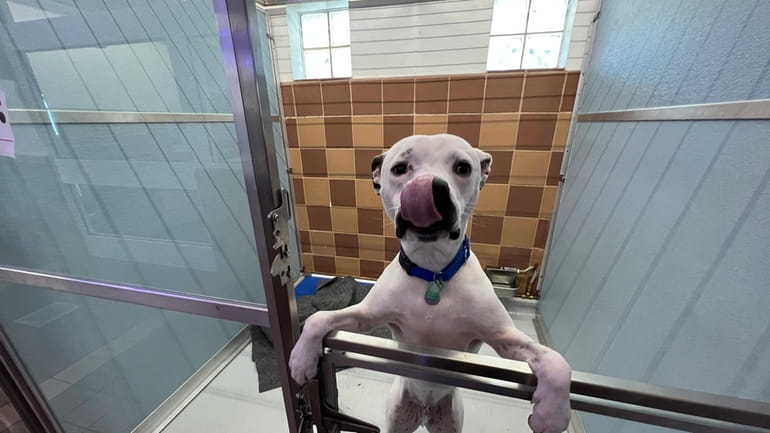Animal lovers should throw local pet shelters a bone

A rescued dog at the North Shore Animal League shelter in Port Washington. Well-funded national groups are crowding out independently operated humane societies, says the author. Credit: AP
The Department of Justice recently filed legal action against Apple, arguing the iPhone maker holds a monopoly over the communications market. The landmark antitrust case is only the latest action taken by the federal government to foster healthy competition within the U.S. economy to protect consumers. When too few companies dominate an industry, most people lose.
Big Tech isn’t the only area that could benefit from more competition. The animal advocacy space is largely controlled by two national organizations that together make absorb more than half a billion dollars in donations every year. With bloated bank accounts and no real competitors to keep operations honest, the groups have gone off the rails — leaving homeless cats and dogs behind in the process.
As the former chief executive of one of the groups, I would know.
The Humane Society of the United States and the American Society for the Prevention of Cruelty to Animals (ASPCA) are by far the largest groups within the animal welfare space, leverage that’s deployed to factory-fundraise via major — and expensive — advertising campaigns. Over the past decade, the philanthropy juggernauts have collected more than $3.7 billion in contributions.
This guest essay reflects the views of Edwin Sayres, senior adviser to the Center for the Environment and Welfare and former president and chief executive of the New York-based American Society for the Prevention of Cruelty to Animals.
With all this cash, the national groups are able to crowd out independently operated neighborhood humane societies, rescues, and other local aid organizations that are in crisis mode. It’s akin to a big box store running a mom-and-pop retail shop out of business.
The Humane Society and ASPCA have combined annual fundraising budgets amounting to more than $100 million a year, enabling these serial marketers to reach a vast audience with gut-wrenching commercials featuring suffering cats and dogs. You’ve likely seen the Sarah McLachlan television ad that pulled on the heartstrings of America during the 2000s. (“For just $18 a month, you can help rescue animals from their abusers.”)
Not only are local and regional animal aid groups outgunned, but the ads are running in their own backyards.
That means donations that would ordinarily be earmarked for local shelters — which are dealing with the bulk of homeless dogs and cats — are being commandeered by the New York- and Washington-based heavyweights. The situation is also exacerbated by name confusion, with 8 in 10 Americans wrongly believing the national groups are umbrella organizations for local pet shelter networks and therefore donate to the former.
The Humane Society does not run a single pet shelter, the ASPCA is unaffiliated with local SPCAs nationwide, and grant programs intended to support community pet shelters have shriveled to nearly nothing. According to the groups’ own tax returns, the organizations give just 1 and 2% of their respective budgets as financial gifts to state-based shelters and rescues.
Don’t take my word for it.
A recent survey from the Center for the Environment and Welfare of nearly 2,000 local pet shelters and rescues finds that 74% of respondents consider their funding levels “inadequate” and nearly two-thirds say donor confusion between their organization and the Humane Society or ASPCA reduces contributions.
Dating back to Standard Oil and, later, the Bell System, the U.S. government has helped to foster dynamic competition within industries to help protect consumers. While Uncle Sam isn’t waiting in the wings to take on the animal welfare duopoly, cat and dog lovers can still do their part by donating locally. Community organizations need to be thrown a bone.
This guest essay reflects the views of Edwin Sayres, senior adviser to the Center for the Environment and Welfare and former president and chief executive of the New York-based American Society for the Prevention of Cruelty to Animals.
